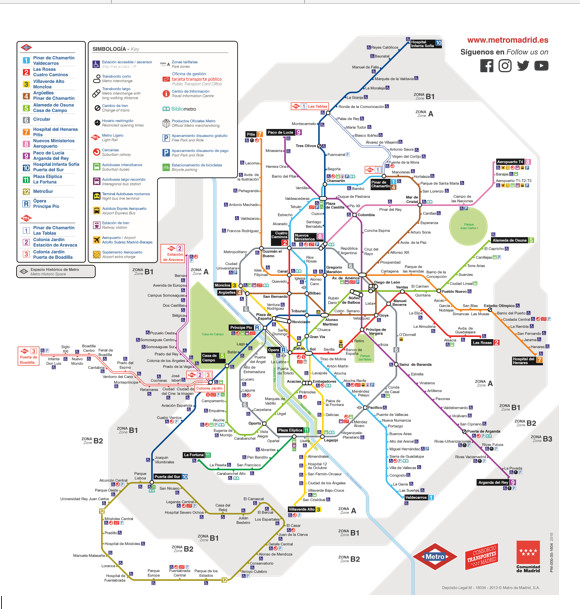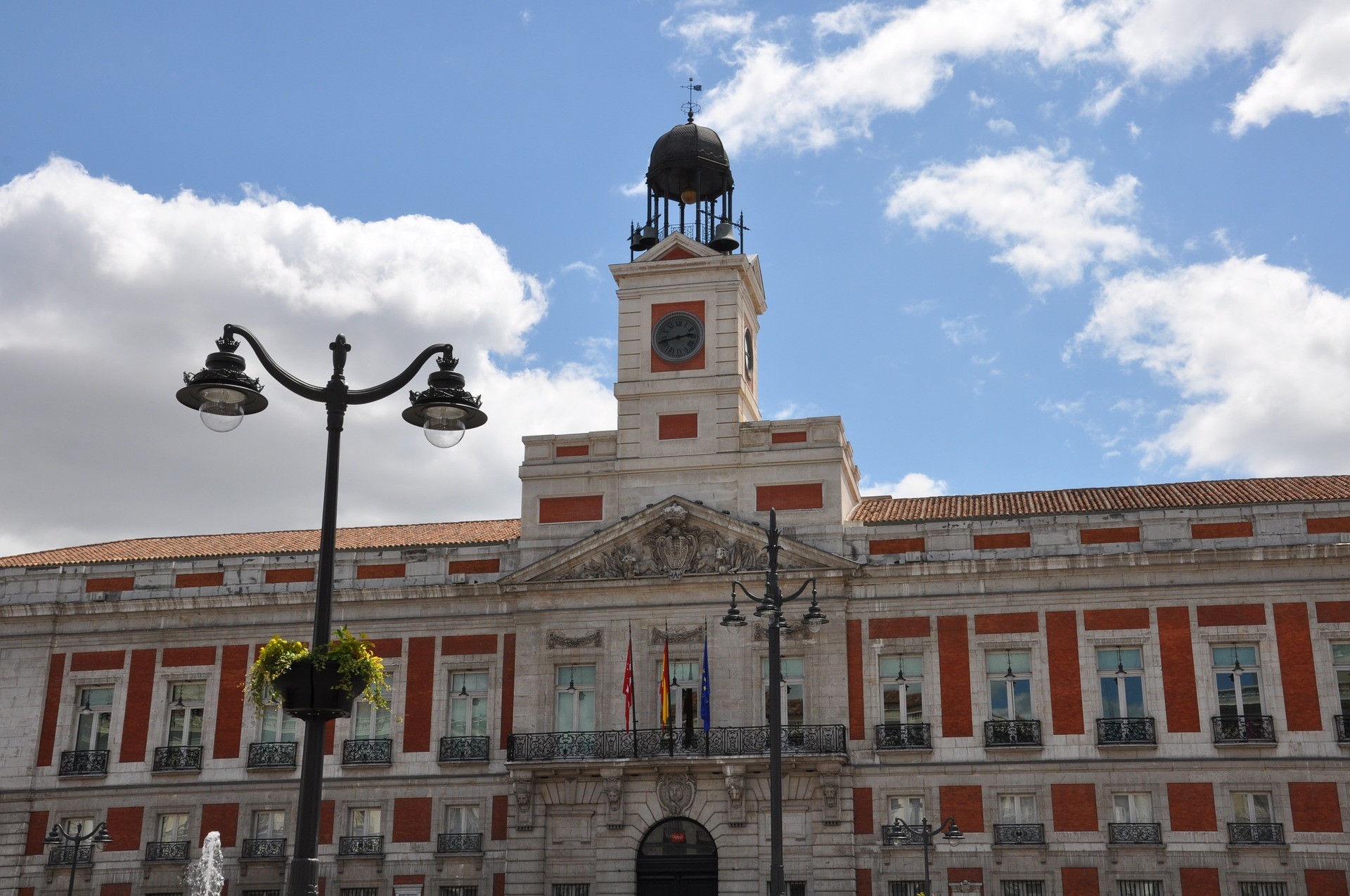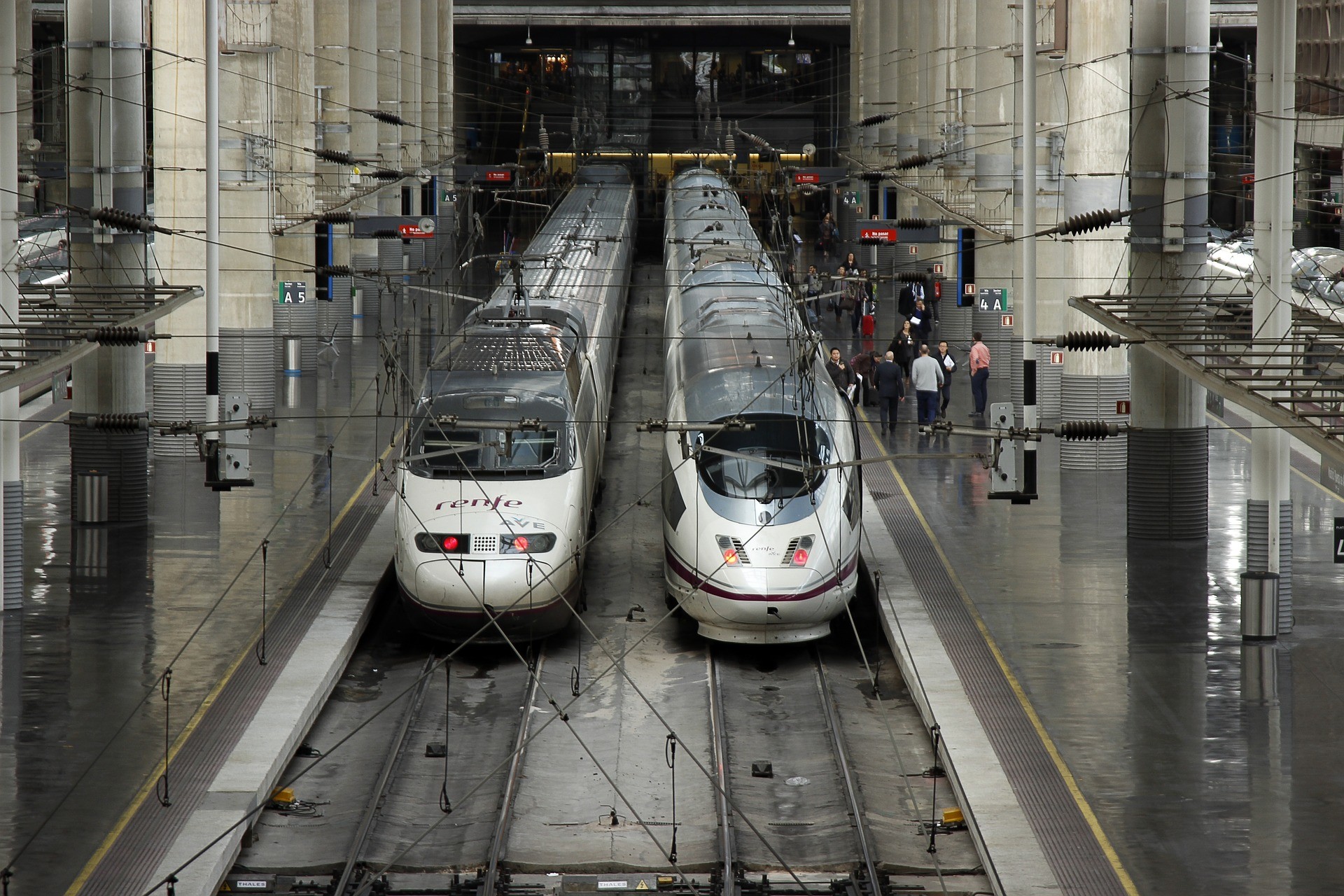Madrid's Metro System
I believe walking is one of the best exercises to do while being in a new city, since it allows you to discover new places and streets that might have some interest, but being honest, we usually want to reach places fast and directly. So, when not having so much time to go for a walk, you can bet Madrid has a great public transport system, including metro, train and buses. You can get to the other side of town in less than an hour, and it reaches the suburbs and villages around it. But the best of it is that anywhere you want to go inside the city you will have some mean of transport to get there, at least very close, even at night. (Maybe I'm making a fool of myself, but on my trips to new lands I haven't enjoyed such a good chance of moving calmly and freely anywhere I wanted without having to walk or wait for and hour or having to take a cab, so that's why I think you might appreciate it).

Of course, you will have to bear in mind the schedule and the place from where to take any mean, so here I leave you what you should remember. I decided to start by the metro system since it is the biggest and maybe most complicated of all, but also the most useful when moving around the city.
Schedule and prices.
Tickets
Money issue: the prices have changed in the past years, increasing due to the crisis, but also have been quite adjusted for the students' and the elderly's use.
There are different types of tickets that are useful for metro, light train, and bus, that you can buy in machines or offices that are at every metro and light train station, or pay for it inside the bus.
But how much you pay changes depending on how many stations you are going to travel, and the area of the city you are moving into. You should know that once you enter the metro system you can change lines as much as you want, but after you exit the validity of your trip is finished, so for a round trip you need to validate twice. Here is the basic list, and you can always check the map of the metro lines to find about the areas and stations:
1. All areas and lines in light train (ML 1, 2 and 3)
Simple (1 validation): 3€
10 validations: 18,30€
2. Area A and light train 1 (ML1): this area includes all the city centre and close neighbourhoods. Is the one you will probably move around the most.
Simple (1 validation): 1, 50€ (1 to 5 stations) / +0, 10 to 2€ (more than 5 stations).
10 validations: 12,20€ (ah, the good old times when it only costed seven euros... ).
When you exit area A, which is where you will probably be living in, even if you stay in the same line you will have to change train and pay a plus for another ticket. So using line 10 for example, once you get to station La Granja you have to change and pay +1, 50€.
3. Area B1 and B2
Northern metro system. (Line 10: La Granja - Hospital I. Sofía).
Eastern metro system. (Line 7: Barrio del Puerto - Hospital Henares).
Southern metro system (all line 12 and station Joaquín Vilumbrales in line 10).
Simple (1 validation): 1,50€.
10 validations: 11,20€.
4. Areas B1, B2 and B3
TFM (line 9: Puerta de Arganda - Arganda del Rey).
Light train: lines ML2 and ML3.
Simple (1 validation): 2€.
10 validations: 12,20€.
For going to the airport there are special fees, and you can either pay for a combined ticket or just use yours from your area and pay for the plus to the airport:
5. Area A + Airport (line 8: terminals 1, 2, 3 and 4)
Simple (1 validation): 4, 50€ (1 to 5 stations) / +0, 10 to 5€ (more than 5 stations)
6. All metro system + Airport
Simple (1 validation): 6€.
7. Only airport ticket.
Simple (1 validation): 3€.
For more info you can check out the official page
Schedule
As you can see, the metro system consists on an intricated net of 12 lines that run through the whole city and suburbs all day. The schedule stays still through the whole week, from 06:05 am until 02:00 am.
What certainly changes is the waiting time at the station, depending on the day of the week and moment of the day, and in less cases depends on the line you have to use. Therefore:
- Early morning: in all lines, you might have to wait for 6 to 9 minutes.
- Midday: in lines 1 to 10 the awaiting time stands around 3 to 5 minutes max. In lines 11 and 12 it goes up to8 minutes.
- Late evening and night: in all lines it increases gradually, from 8 to 15 minutes.
- Weekends: in all lines, the waiting time increases, excepting the most commonly used (1, 2, 3, 5, 10) which stay around the same amount. It may increase 2 or 3 minutes.
On the other hand, the metro system has quite some changes depending on events and days of importance, so if you really give importance to the time you take to get somewhere else, just check their page and their news here.
Busy stations
Talking of each line could take years to be done and to understand, so I see better I tell you which stations themselves are more busy and useful for different reasons, and you can also take it as a suggestion.
- Sol (metro lines 1, 2 and 3): this is certainly one busy station. Not only three metro lines and Train pass through, but it is in the middle of one historical square in the main centre of the city. Around you will find many stores of all kind, usually you can see modern brands set next to old typical Spanish shops, not to mention tons of souvenir places, restaurants and bars. The square is a historical place, where you find the building of Puerta del Sol, where we celebrate New Year's Eve, and which has a great story behind and in front of it! In the ground lies a silver plate indicating Km 0, from where all roads start. If you decide to walk around, you can easily get to Plaza Mayor (Major Square), the Royal Opera and Royal Palace, and main streets such as Gran Vía. It is one of the closest metro stations to the Prado Museum and Thyssen Museum (15 min. walking distance).
- Gran Vía (metro lines 1 and 5) and Callao (lines 3 and 5): these stations have exit to the great avenue of Gran Vía, also filled with stores of famous brands, one casino, hotels, restaurants and theatres, and pubs for night partying. Walking through it offers you a beautiful view of renewed old buildings, and access to streets such as Fuencarral or Hortaleza, that even being also sunk in more shops, have a different style. Here everything tends to be crowded and a little expensive, but you get the sense of the city lifestyle!
- Opera (metro lines 2 and 5, and connection with P. Pio): this station has exit to a square that hosts the Royal Opera building, a historical building, and behind it lies the Royal Palace and the Cathedral of the city next to it, which you can visit. Walking around you have easy access to these touristic sites, and you will be close to the Major Square as well. It is surrounded with nice cafes, music stores, gardens and the most beautiful view you can get of the city. I recommend you to go to see the sunset next to the Royal Palace, you will not regret it.
- Principe Pio (metro lines 6 and 10, and connection with Opera): busy station because it connects directly with the centre and is one main point for students to take the metro towards the University area (line 6). It is an old Train Station to the North-East that still works, but not on the same way, since it has been renewed and turned into a mall. You can enjoy a shopping day, have a meal inside it, or go to the movies. If you walk out, you are just two steps away from the river side and the park Casa de Campo, so take the chance and have a walk around.
- Nuevos Ministerios (metro lines 6, 8 and 10): this part of the city hosts huge buildings and malls, and it is frequented by bussiness people and high class students, since is where many private schools are, close to the most expensive neighbourhoods of the city. You won't only find that of course, but I must admit that I personally feel out of the frame when walking around very formally dressed people that go to work. Anyway, it exits to the huge avenue of Paseo de la Castellana, from where you can take buses further up or back down to the centre. It is also important because is metro line 8's first station, which goes to the Airport.
- Atocha (metro line 1): this station is the main Train Station of the city, from where you can take the high speed trains or the mid-long way trains to far away cities. It hosts a big memorial monument for the terrorist attack it suffered in 2004. If you walk outside, you will find yourself almost in front of the Retiro park and the Reina Sofia Museum, and just 15 minutes away walking from the Prado Museum.

Picture of ''liandra'': Source

Picture from ''alfcermed'': Source
These are the ones I consider most important of all, because of their connections and the places they are set at, but any other close to them is a great exit to historical places or beautiful old neighbourhoods that you should visit if you get the chance (some suggestions could be La Latina, Plaza de España, Chamberí, Chueca, Colon, Goya, and Plaza de Castilla).
Special stations
Not only you get to amazing places using the metro, but you can also visit metro stations themselves. Nowadays many are being renewed in their features and appearance, that end up as little museums. Some beautiful ones are:
- Retiro (line 2): it has an entire wall decorated by a mosaic of people in the park, and some historical characters if I remember well.
- Colón (line 4): besides the exit to the great avenue Paseo de la Castellana and other big streets, Colon has the entrance to the Wax Museum of the city.
- Goya (lines 2 and 4): it is decorated by paintings and pictures of this famous spanish painter from two centuries ago, as well as by charts with historical facts explained about him.
- Chamberí (line 1): itself it doesn't have much, but you can access a museum where the old station is conserved, since it was one of the first built in Madrid.
- Chamartín (line 1): almost for a second, before getting to the current station of Chamartín, you will pass through a slightly lighted ghost station, which is the old one that the city has preserved and lies inside the tunel of line 1.
- Opera (line 2 and 5): similar to others, Opera station hosts a small museum with some ruins of the past square, and a video explanation of how it looked like and its importance.
Velázquez (line 4): again, it is filled with paintings and pictures of Velázquez, one of the greatest classical painters Spain has had.
Atocha (line 1): inside the huge Train Terminal they have built a big garden of tropical plants and a small pool where many turtles and fishes live. You can also visit the monument in memory of the fallen in the terrorist attack.
So far, I think this is enough information. The rest of small details I leave them for you to appreciate and discover yourselves, hoping that you enjoy your small trips inside the city!
Photo gallery
Content available in other languages
- Español: Metro de Madrid
- Italiano: La rete metropolitana di Madrid
Want to have your own Erasmus blog?
If you are experiencing living abroad, you're an avid traveller or want to promote the city where you live... create your own blog and share your adventures!
I want to create my Erasmus blog! →



















Comments (0 comments)